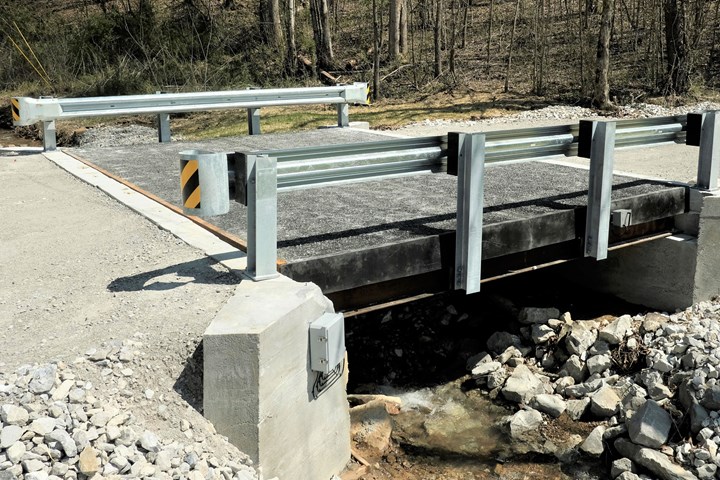
A newly installed composite bridge in north central Tennessee, developed by Structural composites Inc. said to showcase sustainable solution for aging infrastructure. Equipped with a fiber-reinforced polymer (FRP) bridge deck embedded with fiber-optic sensors, it has replaced a damage, decades-old concrete crossing which, like thousands of rural, low volume bridges across the states and nation, was rated structurally deficient and outdated.
Almost a dozen private companies, led by Tennessee-based Composite Applications Group (CAG, McDonald), collaborated with industry organisations and university researchers to make the composite bridge a reality under the Institute for Advanced Composites Manufacturing Innovation (IACMI, Knoxville, Tenn., U.S.).
According to the American Society of Civil Engineers (Reston, Virg., U.S.), about 8%, more than 617,000 bridges in the U.S. are structurally deficient and need repair. FRP composites offer a low-cost, low-maintenance option and the new structure in rural Tennessee and is intended to demonstrate the benefits of composite materials for rural bridge work.
“This composite bridge has already made a positive impact on Morgan County,” says Morgan County Highway Superintendent Joe Miller, who added county officials were looking for a low-maintenance bridge that could be installed fast and at a lower cost than traditional methods. “We have numerous bridges within the county and hundreds across the state that are in need of repair and could benefit from this technology.”
The 16 x 25-foot bridge deck is engineered for high strength and is said to be 90% lighter than concrete. It has two 8 x 25-foot corrosion-resistant FRP deck panels that were fabricated off-site in a controlled environment. Because the completed bridge sections were so lightweight, they could be transported to the bridge site and installed in one day using a forklift, reducing installation time and energy costs by requiring less construction equipment for on-site preparation.
IACMI Technology Manager John Unser, who is also vice president of program and project management for CAG, says composites have been used for bridge deck applications for more than 20 years and have exceeded all performance and safety standards set by the American Association of State Highway and Transportation Officials (AASHTO, Washington, D.C., U.S.). But when it comes to composite bridge decking, he says, many transportation departments across the country, especially those from smaller jurisdictions, are not familiar with the technology.
IACMI and its industry partners are developing a comprehensive case study based on the Morgan County bridge project, including comparing total costs of a typical concrete bridge and one using an FRP bridge deck. Unser says the results will be shared with federal, state and local officials, transportation departments and the civil engineering community so FRP composites will be more a “known” to them.
University of Tennessee, Knoxville (UTK) researchers and engineering students from the Fibers and Composites Manufacturing Facility are part of the bridge partnership. They embedded smart fiber optic sensors developed by Luna Innovations (Roanoke, Virg., U.S.) into the bridge surface during production. These high-density sensors are being used to monitor the composite deck system over time to give critical performance and safety data, thus providing a sustainable solution for aging infrastructures such as bridges. In addition, wireless technology developed at UT is being used for monitoring the response of the bridge system and traffic counts remotely via cloud computing.
“Lack of durability data is one of the major barriers of the adoption of novel and advance materials including carbon-, basalt- or glass fiber-reinforced polymeric composites in civil infrastructure,” says Dayakar Penumadu, the Fred N. Peebles Professor in the Tickle College of Engineering at UT and Characterization Fellow for Materials and Processing for IACMI.
Penumadu adds, “this is a major obstacle for integrating new materials and structures quickly and thus require successful demonstration as being done through this IACMI project. Bridge decks are the most damage prone elements, and we are integrating smart sensors distributed throughout the composite bridge deck that will provide us valuable performance data with time for years to come.”
News and Image Source – Institute for Advanced Composites Manufacturing Innovation – IACMI
